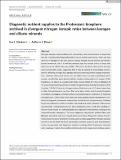Diagenetic nutrient supplies to the Proterozoic biosphere archived in divergent nitrogen isotopic ratios between kerogen and silicate minerals
Abstract
Nitrogen isotopes and abundances in sedimentary rocks have become an important tool for reconstructing biogeochemical cycles in ancient ecosystems. There are two archives of nitrogen in the rock record, namely kerogen-bound amines and silicate-bound ammonium, and it is well documented that the isotopic ratios of these two archives can be offset from one another. This offset has been observed to increase with metamorphic grade, suggesting that it may be related to the bonding environment in differing nitrogen host phases and associated equilibrium isotope fractionation. However, theoretical bounds for this effect have not been established, and it remains possible that some isotopic offsets predate metamorphism. In support of this hypothesis, we report an unexpectedly large isotopic offset of 4–5‰ in siltstones of very low metamorphic grade from the late Mesoproterozoic Diabaig Formation in NW Scotland (1.0 Ga). Carbon to nitrogen ratios of bulk rocks are 2–3 times lower than in other Mesoproterozoic sections. The rocks also contain early-formed phosphate concretions and display wrinkled surfaces on bedding planes, indicative of fossilised microbial mats. Collectively, these data are most parsimoniously interpreted as evidence of diagenetic ammonium release from microbial mats into porewaters, followed by partial oxidation to nitrite or nitrate at the sediment–water interface. This process would render residual ammonium in clays isotopically heavy, while the resulting nitrite or nitrate would be relatively lighter and captured in new biomass, leading to the observed isotopic divergence. The same diagenetic degradation pathway likely also liberated phosphate that was trapped within concretions. Diagenetic release of nutrients is known to occur in modern settings, and our data suggest that nitrogen isotopes may be a way to track this local sedimentary nutrient source in past environments. Lastly, we speculate that diagenetic nutrient recycling within Proterozoic microbial mats may have created a favourable niche for eukaryotic organisms in shallow waters.
Citation
Stüeken , E E & Prave , T 2022 , ' Diagenetic nutrient supplies to the Proterozoic biosphere archived in divergent nitrogen isotopic ratios between kerogen and silicate minerals ' , Geobiology , vol. 20 , no. 5 , pp. 623-633 . https://doi.org/10.1111/gbi.12507
Publication
Geobiology
Status
Peer reviewed
ISSN
1472-4677Type
Journal article
Description
Funding: Natural Environment Research Council (Grant Number(s): NE/V010824/1; Grant recipient(s): Eva Stüeken).Collections
Items in the St Andrews Research Repository are protected by copyright, with all rights reserved, unless otherwise indicated.

